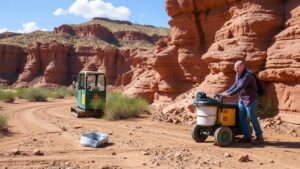Techniques for Locating Lost Valuables in High-Probability Areas Using Dowsing
Techniques for Locating Lost Valuables in High-Probability Areas Using Dowsing
Dowsing, often referred to as water witching, is a practice that employs various tools and techniques aimed at locating lost objects–including valuables–by sensing changes in energy. This article explores the principles of dowsing, its effectiveness, and techniques for applying it to find lost items in high-probability areas.
The Fundamentals of Dowsing
Dowsing traditionally involves the use of a forked stick, rods, or pendulums. Practitioners believe that these tools can detect the presence of hidden objects or water by responding to subtle earth energies. psychological and intuitive aspects of dowsing contribute significantly to its practice. Research suggests that dowsing may stem from the practitioner’s heightened sensitivity to environmental cues rather than any supernatural powers.
Identifying High-Probability Areas
Identifying high-probability areas for finding lost valuables is crucial. Here are several strategies:
- Recent Activity: Focus on areas where the item was last seen or where someone has recently lost something. This increases your chances of success.
- Common Misplacement Locations: Certain areas, such as near doors, car entry points, or recreational spots, are common for losing items.
- Historical Context: Some regions hold a reputation for frequent losses — for example, busy public parks where items like phones or wallets might be dropped.
Techniques for Effective Dowsing
While dowsing can appear straightforward, employing certain techniques can significantly enhance the practice. Here are some methods:
- Choosing the Right Tools: Traditional dowsing rods or pendulums can be effective. For example, dowsing rods can be fashioned from wire, providing a personal touch to the tool that may aid in building a practitioner’s confidence.
- Grounding and Centering: Prior to dowsing, it’s beneficial to engage in grounding techniques which may include deep breathing or meditation. e practices help focus your energy and intentions.
- Setting Intentions: Clearly defining what you are searching for can create a mental pathway that enhances sensitivity. For example, stating, “I seek my lost earrings,” makes the search more purposeful.
Case Studies and Real-World Applications
Numerous anecdotal instances highlight the effectiveness of dowsing. A notable case involves a dowsing practitioner who successfully located a lost wedding ring in a large, grassy field. After analyzing the area and identifying a high-probability zone based on where the couple had been sitting, the dowser used rods that crossed over the exact spot of the ring.
Another case involved an artist who mislaid valuable materials at a festival. By dowsing near the last location where they were working, they were able to recover both their supplies and the lost treasure of creativity — their inspiration.
Addressing Common Questions and Concerns
While dowsing is popular, it raises questions regarding its legitimacy and accuracy. Critics point to a lack of scientific evidence supporting dowsing claims. But, many practitioners argue that success stories and personal experiences hold inherent value. It is important to approach dowsing with an open mind while coupling it with conventional methods of searching.
Actionable Takeaways
For those interested in exploring dowsing as a technique for locating lost valuables, here are practical steps to follow:
- Gather your tools: Create or procure your preferred dowsing instruments.
- Prepare mentally: Take time to center yourself before commencing your search.
- Analyze high-probability areas: Use knowledge of the situation to guide your search location.
- Keep an open mind: Be receptive to the unexpected results and validate your findings through traditional search methods.
To wrap up, while dowsing may lean towards the unconventional, its rich anecdotal history and methods present a unique avenue for locating lost valuables. By employing strategic techniques in high-probability areas, individuals seeking to recover their possessions can enhance their chances of success in this engaging search endeavor.


